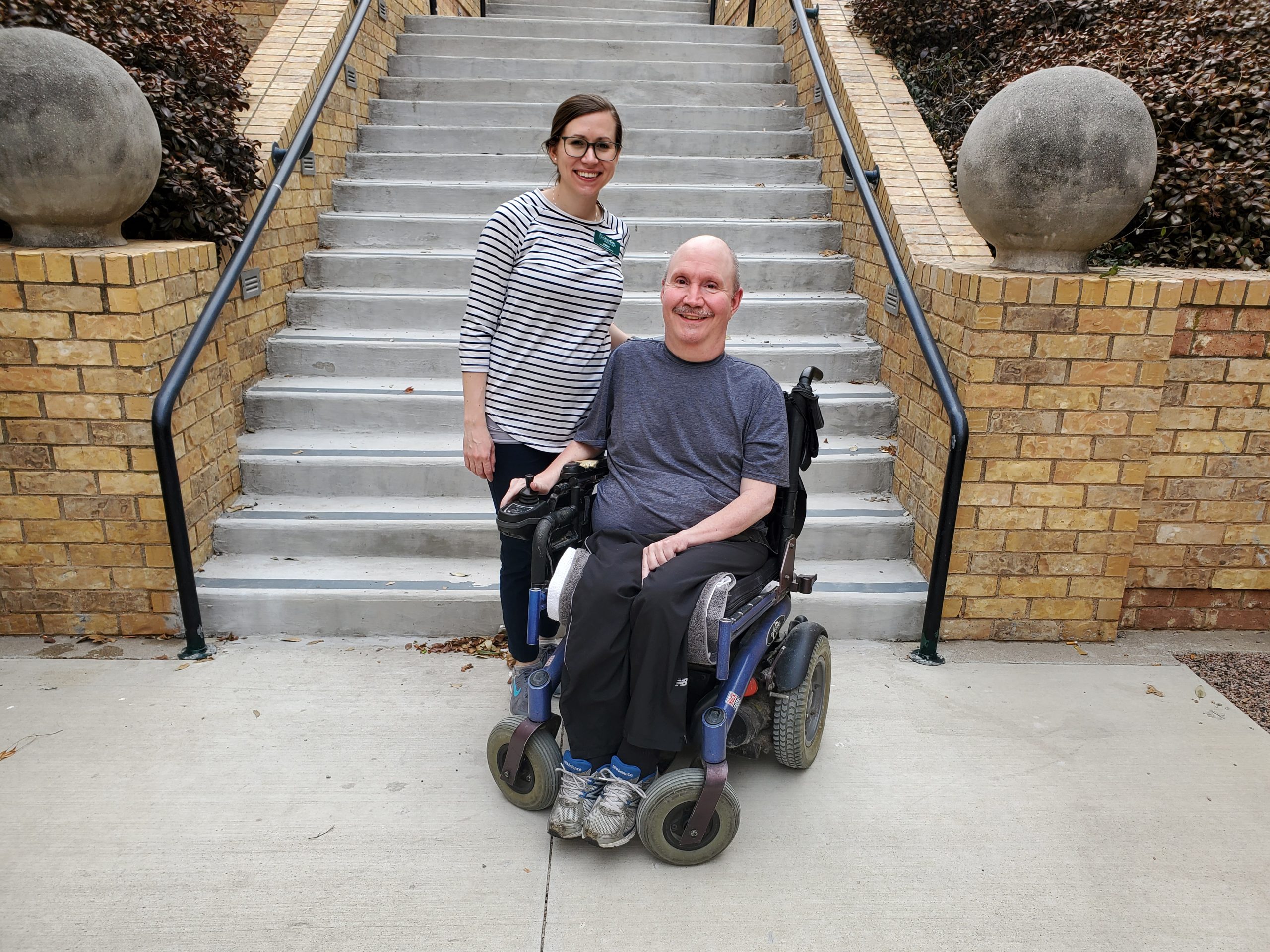Q&A Between Physical Therapist and SMA Patient

Michael and I have been working together for the past couple of years, and while speaking with each other about my March HCP article, we thought that doing a question-and-answer article would be interesting. Michael would ask me 5 questions, and I would ask him 5 questions. We hope that this question-and-answer article will answer some of the questions that you may have regarding physical therapy for patients with SMA.
Michael’s Questions to Emily
QUESTION: What were your reactions [questions, concerns, fears, anxiety, etc.] when you found out that you would be my primary PT? ANSWER: While I had worked with Michael when assisting his primary PT, Laura, I hadn’t really worked with him on my own until she was unable to continue to transfer him to the physical therapy table due to her pregnancy. I didn’t have any fears or anxiety about working with him before that point. My main concern was that he may not trust me and allow me to make changes and decisions regarding his physical therapy due to working with Laura for so long. I was nervous to ask Michael to try new exercises, thinking he may not trust me and my clinical judgment, or trust himself that he could perform the exercises with my assistance. After just a few weeks of working with Michael, we formed a trusting relationship in which he trusted my suggestions and assistance.
QUESTION: How have you grown with regards to your PT skills, after working with a patient with SMA? ANSWER: Working with Michael, a patient with SMA, has helped me to become more confident in working with diagnoses that are less common in the physical therapy outpatient world. Michael has helped me to learn that not all of what you see in textbooks will apply to each patient in the same way. He’s helped me to think outside of the box and really make specific treatment plans for him and his abilities and specific goals. He always makes sure to keep me updated on new studies being done, as well as educating our students we have in the clinic. Michael is always willing to work with our students to makes sure they are educated in what SMA is, and how it affects people and their motor skills and ability to perform everyday activities, while allowing them to ask any questions they may have.
QUESTION: How difficult was it for you to come up with new exercises for a patient who had SMA? ANSWER: At first, it was very difficult to come up with exercises for Michael, until I worked with him long enough to become familiar with his abilities. Once I became more aware of what activities he could and couldn’t perform, it became easier to try new exercises. Once we built a trusting relationship, it was easier for me to develop new exercises to improve his functional abilities throughout his daily life. It has also become simple to modify the exercises in different ways to fit him and his needs. We have performed exercises such as assisted bridging and assisted rolling side to side on the table, to increase his ability to participate in activities such as bed mobility and dressing of his lower extremities at home.
QUESTION: Have you noticed any changes with regards to my physical abilities? ANSWER: I have noticed a significant increase in not only Michael’s physical abilities but his confidence as well. He’s now able to ascend and descend ramps without assistance to maintain an upright posture, due to an increase in core and neck strength. He’s also able to sit unassisted on a therapy table with a cushion underneath him, to increase the difficulty and offset his balance. For Michael, physical therapy is as much mental as it is physical. This is a chance for him to get out of the house and focus on his body and bettering himself. Like most people, Michael typically feels better, physically and mentally, after each visit.
QUESTION: If you were in an auditorium giving a lecture to other physical therapists, what advice would you give them if they had an opportunity to work with an SMA patient? ANSWER: I would say be flexible. Know that each patient will present differently, just like any other diagnosis. I would also say SMA patients will likely be with you for a long time, so become familiar with them and their goals as well as realistic abilities. Give them a chance to speak and give suggestions for their treatment. Ultimately, they are doing this to better themselves, and, most likely, they want to be there. Also, be encouraging and uplifting each visit. There may be things you want to try that the patient doesn’t feel like he or she can accomplish. Take baby steps toward that exercise and give the patient encouragement while progressing towards the exercise. Remember, this doesn’t come easy or natural to them, and you will need to build their trust to have a successful treatment.
Emily’s Question To Michael
QUESTION: What advice would you give someone who may be skeptical about PT, with or without SMA. ANSWER: My advice to any patient that’s thinking about taking PT, would be to find a physical therapist that you feel comfortable working with. Trusting your physical therapist is key to a successful outcome. I’ve been extremely fortunate to build a trusting relationship with each one of my physical therapists. Emily, the physical therapist that I’m working with now, has a great disposition and attitude, and she makes physical therapy fun. If you’re working with a physical therapist that you don’t trust, you’ll never be able to open up and be honest with them regarding your treatments. If you have a physical therapist that you trust, you’ll not only enjoy physical therapy more, your outcome will probably be much better with regards to your recovery.
QUESTION: What’s been your best accomplishment during PT? ANSWER: I think my biggest accomplishment was conquering my worst fear. SMA patients typically do not have the ability to sit unassisted. Without back or lateral supports, SMA patients tend to lose their balance. After working for nearly a year on strengthening my core, which included my abdominals, back, shoulder, and neck muscles, my physical therapists transferred me from my wheelchair to the therapy table. After about 5 minutes of making sure that I was in the right position, and making sure that I was also comfortable, I was astonished at the fact that I could sit without any support on my back or my sides. This was an extremely emotional point of my therapy because I realized that I still have the ability to do something that I hadn’t been able to do in nearly 40 years. I can also tell you that it was also an emotional time for my physical therapists because they got excited witnessing me having success in something that I worried about for so long.
QUESTION: What’s been your least favorite thing about PT? ANSWER: I would have to say that my least favorite exercise were the ones that we did on my feet and ankles. I quit wearing footrests on my wheelchair when I was in junior high, and this caused a considerable amount of atrophy in my ankles and feet. Working to pull my feet back into dorsiflexion was difficult. Most patients with SMA will tell you that their feet are the most sensitive parts of their body because we typically don’t use them. Even though this wasn’t my favorite part of PT, we’ve definitely seen some improvements, and now, my feet are not near as sensitive as they used to be.
QUESTION: What’s been one thing that we haven’t tried during PT that you would like to try in the coming months? ANSWER: Now that I feel more comfortable sitting in my wheelchair, especially regarding my balance, I would like to be able to take my wheelchair outside and put myself in compromising positions regarding balance, to see what my strengths and weaknesses are. Emily and I have worked on the ramp outside of her outpatient clinic, but when the weather warms up, we plan to go through the local shopping center, so she can work with me on rolling my wheelchair on uneven surfaces, which is typically been something that I’ve avoided in the past.
QUESTION: What’s your main goal for PT? ANSWER: Until there’s an FDA-approved treatment that specifically targets the building of muscle, my main goal in physical therapy is to maintain what physical strength I have right now. Each neuromuscular progressive disease presents different challenges, and with SMA, maintaining muscle strength can be challenging. There’s currently a treatment in a clinical trial that’s going to target muscle growth and muscle mass, but until this treatment gets FDA approval, which should be by the end of this year or the first part of 2022, maintaining what physical strength that I currently have is the most important objective during my physical therapy.

